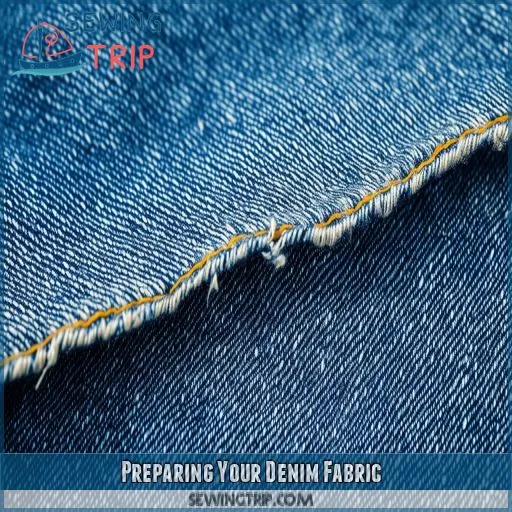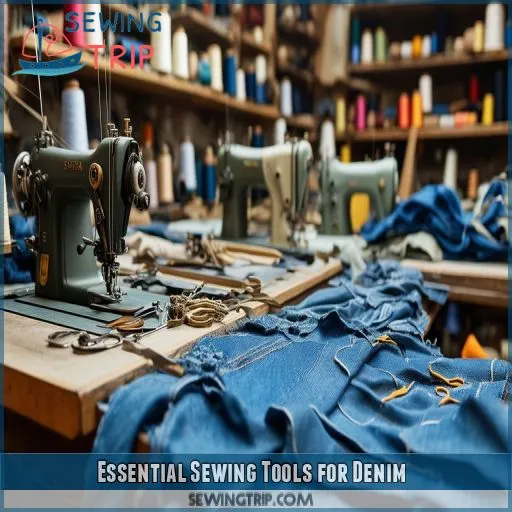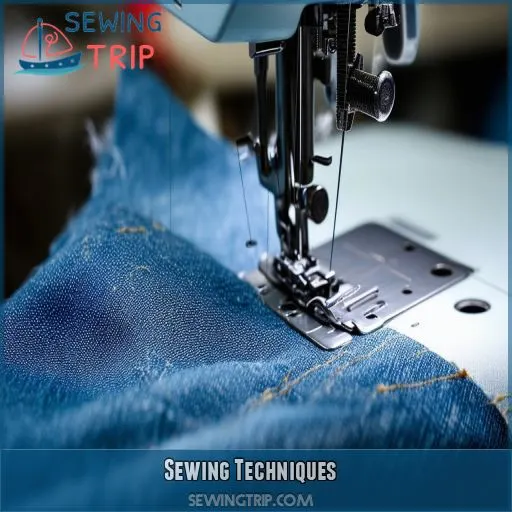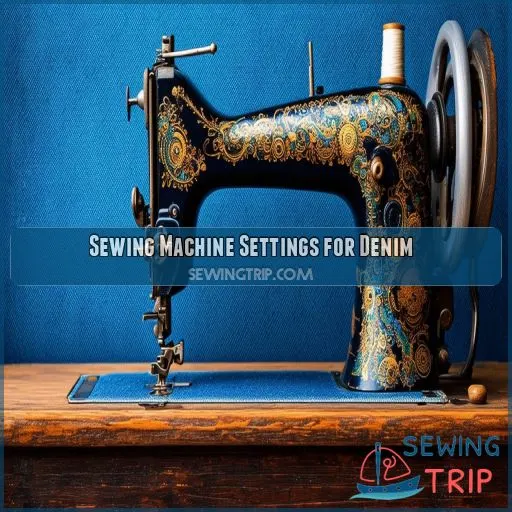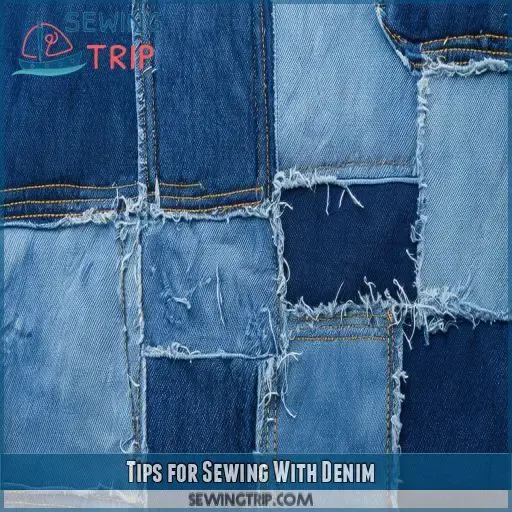This site is supported by our readers. We may earn a commission, at no cost to you, if you purchase through links.
 Discover if mastering denim sewing at home is truly achievable. You’ll obtain the ability to create professional-grade denim pieces with our guide to sewing denim at home. In just 9 easy steps, you’ll learn pro techniques for 2024.
Discover if mastering denim sewing at home is truly achievable. You’ll obtain the ability to create professional-grade denim pieces with our guide to sewing denim at home. In just 9 easy steps, you’ll learn pro techniques for 2024.
From selecting the right fabric to mastering essential tools and stitches, you’ll gain the skills to tackle any denim project. Whether you’re a beginner or experienced sewist, these tips will elevate your craft and liberate your creativity.
Get ready to conquer denim like a pro.
Table Of Contents
- Key Takeaways
- Choosing the Right Denim
- Preparing Your Denim Fabric
- Essential Sewing Tools for Denim
- Sewing Techniques
- Sewing Machine Settings for Denim
- How Do I Cut Denim?
- Which Thread Should I Use for Sewing Denim?
- Which Needle Should I Use When I Sew Denim?
- Tips for Sewing With Denim
- Frequently Asked Questions (FAQs)
- Conclusion
Key Takeaways
Conquer denim like a pro with our expert guide to sewing denim at home. Master denim by learning how to choose the right one, prepare your fabric, and select the essential tools. Discover techniques used by professionals for reinforcing seams and creating flat-felled seams for a polished finish. Get ready to take on any denim project with the confidence that you are using the latest sewing techniques from 2024.
Choosing the Right Denim

When choosing denim for your sewing project, you’ll need to examine weight, stretch, and color options. You’ll find denim in various weights from lightweight to heavyweight, with or without stretch, and in a range of colors and washes to suit your needs.
Weight And Thickness Options
When choosing denim, weight and thickness are essential elements. You’ll encounter:
- Lightweight (4-8 oz): Perfect for shirts and summer wear
- Medium-weight (8-12 oz): Ideal for everyday jeans and jackets
- Heavyweight (12+ oz): Durable for workwear and rugged projects
Stretch Vs. Non-Stretch Denim
Now that you’ve considered weight, let’s explore stretch vs. non-stretch denim. Your choice impacts both sewing techniques and garment fit. Here’s a quick comparison:
| Feature | Stretch Denim | Non-Stretch Denim |
|---|---|---|
| Comfort | High | Moderate |
| Durability | Moderate | High |
| Ease of Sewing | Moderate | Easier |
| Fit | Form-fitting | Structured |
| Best For | Jeans, skirts | Jackets, overalls |
Stretch denim offers more flexibility for form-fitting designs, while non-stretch provides classic structure. Choose based on your project’s needs and your sewing skill level.
Color And Wash Varieties
When selecting denim, you’ll encounter a rainbow of options. From classic indigo to trendy pastels, denim dyeing techniques offer endless possibilities.
Acid wash and stonewash create that lived-in look, while bleaching can give your fabric a sun-kissed vibe. Don’t forget vintage fades – they’ll add character to your jeans.
Each wash affects how the fabric behaves, so choose wisely for your sewing project.
Preparing Your Denim Fabric
Now that you’ve chosen your denim, it’s time to prep it for sewing. Start by pre-washing your fabric to prevent future shrinkage. Toss it in the washer and dryer as you’d wear it. This step is essential for achieving that perfect fit.
Once clean and dry, press your denim with a hot iron. This smooths out wrinkles and makes cutting a breeze. For thick denim, consider using a clapper to really flatten those seams.
Before you start stitching, reinforce stress points with interfacing. This extra step prevents fraying and adds durability to your project.
Lastly, swap out your regular needle for a denim needle. Its sharp point and strong shaft will power through multiple layers without breaking. Don’t forget to pair it with heavy-duty thread for maximum strength. With these prep steps, you’re ready to tackle any denim project like a pro!
Essential Sewing Tools for Denim
Now that you’ve prepped your denim, it’s time to gather the right tools for the job. You’ll need a Jean-a-ma-jig, a game-changer for tackling thick seams. Don’t forget sharp denim scissors or a rotary cutter for clean, precise cuts. A Teflon foot is your secret weapon against fabric sticking to your presser foot.
When sewing denim, you’ll want to adjust your machine settings. Increase your stitch length to 3.5-4mm for stronger seams. A walking foot can help feed thick layers evenly. Don’t skimp on needles – invest in heavy-duty denim needles to prevent breakage.
Sewing Techniques
When sewing denim, you’ll want to master a few key techniques to guarantee your projects are sturdy and professional-looking. Start by reinforcing your seams with a second row of stitching, which adds strength to high-stress areas. Flat-felled seams are your best friend for durability, while a double-fold hem prevents fraying and gives a clean finish.
For a polished look, try these techniques:
- Topstitching with contrasting thread for a classic jeans appearance
- Embroidery to add personalized flair to your denim creations
- Distressing techniques for a worn-in, vintage vibe
Don’t forget to finish your seams! Serging or using a zigzag stitch will prevent fraying and extend the life of your denim projects. With practice, you’ll be able to tackle various seam types and edge finishes like a pro, giving you the power to create custom denim pieces that’ll turn heads.
Sewing Machine Settings for Denim
Now that you’ve mastered the essential sewing techniques, let’s delve into adjusting your machine settings for denim. Start by adjusting the tension to accommodate the fabric’s thickness. You’ll want to increase it slightly, but be careful not to overdo it. For bobbin thread, opt for a heavy-duty option that can withstand the strain. For topstitching, use a contrasting color thread for that classic denim look.
Don’t forget to increase your needle size to handle the tough fabric – a size 16 or 18 should do the trick. Match your thread weight to your needle size for ideal results. As you sew, keep an eye on your feed dogs to guarantee they’re moving the fabric smoothly. If you encounter thick seams, use a hump jumper to maintain even stitching. These settings, combined with your newfound techniques, will have you conquering denim projects like a pro!
How Do I Cut Denim?
Now that you’ve got your machine settings dialed in, it’s time to tackle cutting your denim. Proper cutting is essential for achieving professional results. Here are three key tips for cutting denim like a pro:
- Use sharp scissors or a rotary cutter
- Follow the grain line carefully
- Mark your pattern pieces accurately
When cutting denim, consider its weight. Lightweight denim is easier to handle, while medium-weight is ideal for trousers and jackets. Pay close attention to pattern placement, ensuring you align pieces correctly for proper fit and style. To prevent fraying, consider using pinking shears or applying a fray check solution to cut edges. For seam reinforcement, leave extra allowance where needed. If you’re into distressing techniques, mark areas for intentional wear before cutting. Remember, precise cutting sets the foundation for successful denim projects, whether you’re machine sewing or opting for hand sewing methods.
Which Thread Should I Use for Sewing Denim?
Now that you’ve cut your denim, let’s discuss thread. For denim, you’ll want to use a heavy-duty thread that can withstand the wear and tear. Opt for a cotton-wrapped polyester thread or an all-polyester thread with a weight of 30 or 40. These threads provide the ideal balance of strength and flexibility for your denim projects.
Regarding color, match it to your fabric or go for a contrasting look with topstitching thread. For added durability, consider using a thread with a special finish that resists abrasion. Remember, the right thread can make or break your project, especially when you’re hemming or hand sewing.
For beginners, start with a medium-weight thread on simpler projects like tote bags or placemats before tackling more complex designs.
Don’t forget to use a hammer for bulk reduction in thick seams!
Which Needle Should I Use When I Sew Denim?
Now that you’ve chosen the right thread, let’s address the essential question of needle selection. When sewing denim, you’ll need a needle that can handle the fabric’s weight and resist breaking. Opt for a denim or jeans needle, typically sized 90/14 to 110/18, depending on your denim’s weight. These needles have a sharp point and a strong shaft, perfect for piercing through thick layers.
For lighter denim, a 90/14 needle should suffice, while heavier weights might require a 100/16 or 110/18. Remember, the needle’s strength directly impacts your stitch quality and thread durability. If you’re experiencing skipped stitches or thread breakage, try moving up a size.
Always start with a fresh needle when working with denim – it’ll make a significant difference in your seam reinforcement and overall project success.
Tips for Sewing With Denim
Ready to conquer denim? Here are some pro tips to help you master this sturdy fabric. First, tackle denim shrinkage by pre-washing your fabric. This’ll prevent any unwelcome surprises after you’ve poured your heart into your project. When you encounter fraying denim, finish those edges like a boss. Use a serger or zigzag stitch to keep your seams neat and tidy. Don’t forget to adjust your machine tension – denim’s thickness can throw things off balance. Experiment with different settings until you find the sweet spot. For a polished look, explore various seam finishes. Flat-felled seams are your secret weapon for durability and style. And if you’re feeling adventurous, try hand sewing for those tricky spots or custom details.
- Picture yourself effortlessly gliding through layers of denim with a sharp needle
- Envision perfectly flat, professional-looking seams that rival store-bought jeans
- Imagine the satisfaction of distressing your denim creation for that lived-in look
Frequently Asked Questions (FAQs)
Can I sew denim on a regular sewing machine?
Yes, but go slowly, use a denim needle, and consider a walking foot attachment to help feed the fabric smoothly.
What is the best stitch for sewing denim?
Measure twice, cut once."
The best stitch for sewing denim depends on the type of denim you’re using. For non-stretch denim, use a straight stitch with a length between 0 mm and 0 mm. If you’re using stretch denim, opt for a stretch stitch like a narrow zigzag.
Do I need a special needle to sew denim?
Yes, you’ll need a special needle for sewing denim. Look for a jeans or denim needle with a reinforced blade and a modified medium ballpoint. These are designed to penetrate thick woven fabrics with minimal needle deflection, reducing the risk of needle breakage.
Is denim difficult to sew?
Sewing denim isn’t rocket science. But it’s not a walk in the park either. If you follow some simple tips, you’ll find denim rewarding and durable to sew. Medium to heavy-weight denim can be bulky at the seams, so use a hammer to flatten it.
What denim weight is best for beginners?
For beginners, it’s best to opt for mid-weight denim, which is typically categorized as 12-18 ounces. This weight offers a good balance between durability and comfort, allowing you to create sharp looks without the discomfort of heavyweight denim.
How do I prepare denim for sewing?
Before sewing, prewash your denim separately in warm water to prevent shrinkage and bleeding. Dry, iron, and cut your fabric, using sharp shears or a rotary cutter.
Can I use regular needles and thread?
Universal domestic machine needles and regular thread can be used for light and medium-weight denims. However, for heavier denim, a specialist denim needle and strong thread are recommended.
How do I cut denim without fraying?
To cut denim without fraying, mark the desired length with fabric chalk or pins. Cut straight across one pant leg, then fold the jeans in half and use the first cut leg as a guide for the second. Cut slightly below the marked line to allow for fraying.
What stitch length is best for denim?
For topstitching, a stitch length of 3 to 5mm is recommended. If you’re working with heavy denim, use a stitch length of around 3mm.
Conclusion
Sewing denim at home is a challenging yet rewarding endeavor. With the right guidance, you can achieve professional-grade results.
This thorough guide has equipped you with the knowledge to tackle any denim project. From choosing the perfect fabric to mastering essential tools and techniques, you’ve gained the skills to create durable and stylish denim pieces that reflect your unique creativity.
Now, go forth and conquer denim sewing, armed with the pro techniques of 2024!

